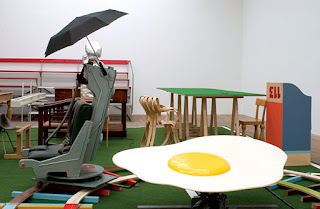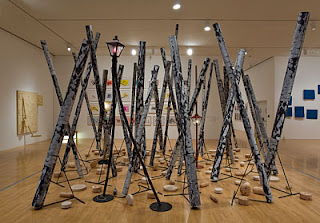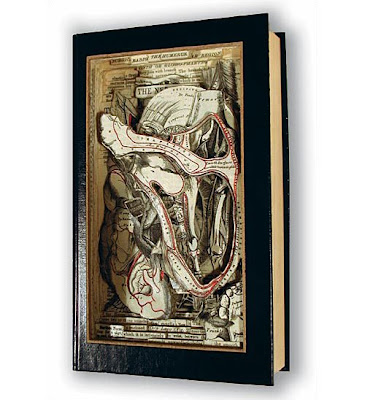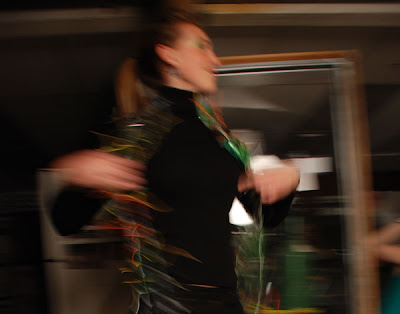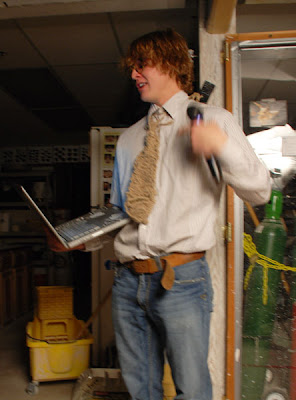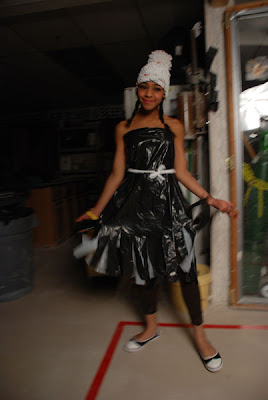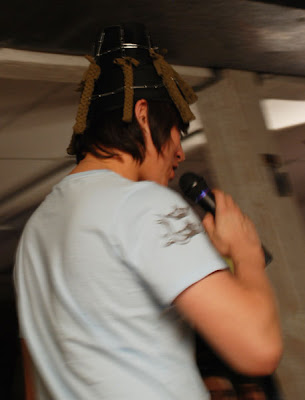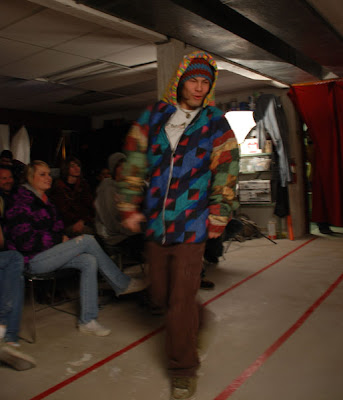
I took the two sections of the Beginning Digital Darkroom class to the Nevada Museum of Art. As usual, there was a good mix of exhibits on display; I hope to post about some of the other exhibits in the coming days, but thought I'd start with Romello Yu's
"Remembering Abu Ghraib," now in the media gallery. It touches on some issues that recently came up in class, particularly in regard to an assignment in which the students had to make a poster-sized image that was in some way a response to the war in Afghanistan and/or Iraq.
One of the problems that immediately comes up in the assignment (at least for those who focus on the horrors of war) is: how do you represent something horrible without abstracting it in such a way that the horror is aestheticized?
It's a bind that I don't think Yu escapes. He has created stylized versions of the poses found in the Abu Ghraib photos, utilizing
Tangrams. The work is clearly not done in bad faith -- I don't have any sense that Yu is trying to exploit the photos, or the people in them, in any way. He wants to show the prisoners as manipulatable objects, but I don't know that his commentary -- "prisoners as playthings" -- is an insight that's compensated for by the aura of abstraction and aestheticization it's wrapped in.

It reminded me of Botero's
paintings and drawings on Abu Ghraib, which I saw displayed a couple years ago in Berkeley. Those were clearly acts of sympathetic imagination; the focus of the paintings is squarely on the prisoners, usually to the exclusion of the guards, in a way that is meant to put the viewer right there in the prison cell with them. And yet I felt there was something redundant about these images, which affected me far less viscerally, less deeply, than the photos themselves. Seeing the originals -- displayed on my computer in the middle of a work day when I was working as an art director, taking a break from my current assignment to take a peek at the day's news -- was a real gut-punch. I felt like I was covered with a nauseating slime for about a week afterwards.
That the Abu Ghraib photos seem to make subsequent visual interpretations seem redundant is not to say there's nothing to say about them, beyond the blunt horror of their evidence of abuse. They could be talked about in relation to a number of things: the history of lynching photos and postcards (it wasn't until I read an article on the book "Without Sanctuary: Lynching Photography in America" that it occurred to me that lynching photos weren't taken as exposés, but rather as souvenirs), gender relationships, frat hazing rituals, pornography.
In some way, in their cruelty and in the strangeness of how the cruelty was expressed, they beg to be examined, to be understood. There's something fundamentally mysterious about their existence at all, as photos. Why were they taken? Why do they seem to have a sickening veneer of tourist photography to them? Certainly some of them were taken in an extension of the cruelty of the acts they were recording -- underlining an act of humiliation by making a note of it, something that could be distributed beyond the moment itself. Keeping the humiliation for posterity.

Some of the motives for the photos seem to have been more complicated and conflicted.
Sabrina Harman, who took several of the photos, claimed in an interview that one of the reasons she took the photos was because she could hardly believe what she was seeing, so she wanted to record what was happening, as a way of confirming it to herself. She wasn't the one who leaked the photos, and her rationale may be self-serving, but I suspect there's at least an element of truth to it.
I have a suspicion that the Abu Ghraib photos will always defeat the visual artist (though I can imagine a play, a film, a novel or a documentary expanding our understanding of those images). I think visual artists will nonetheless continue to respond to them -- partly because their impact is so visceral, and responding to them visually is a way of trying to psychologically metabolize them. I think, also, there is an impulse to cling to the social relevance of image-making, in an environment where visual culture seems to have its own autonomy, its own overpowering ubiquity, rendering the visual artist a mere asterisk in a strangely impersonal and massive transaction.
The Abu Ghraib photos are facts that defy art, even the artfulness of
looking: in the way that even photos taken in extremis -- the photo of Robert Kennedy's assasination, say, or Eugene Smith's photo of a WW2 American soldier holding a dying baby in the Saipan mountains -- seem composed, seem to have been taken in by a thoughtful eye. The Abu Ghraib photos weren't taken by witnesses, but by perpetrators -- images that weren't taken in an act of seeing, but in an act of blindness. There's a powerful feeling of schizophrenia in them -- what is so clearly evident in the photos is something those who took the photos were not seeing. It's natural for an artist to attempt to reclaim those images from the blank stare that first captured them. No matter how quixotic that errand may be.
